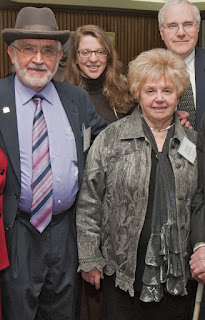 Eugenio Gentili-Tedeschi was born in Italy in 1916. In the aftermath of the Great War, his hometown of Turin became a hotbed of social unrest, and he witnessed a great deal of political violence as the Fascists sought to suppress socialists and other left-leaning movements. When Eugenio was ten years old, Mussolini instituted emergency measures to consolidate his dictatorial powers after several assassination attempts on his life.
Eugenio Gentili-Tedeschi was born in Italy in 1916. In the aftermath of the Great War, his hometown of Turin became a hotbed of social unrest, and he witnessed a great deal of political violence as the Fascists sought to suppress socialists and other left-leaning movements. When Eugenio was ten years old, Mussolini instituted emergency measures to consolidate his dictatorial powers after several assassination attempts on his life.By the mid 1930s, Germany’s support for Italy’s invasion of Ethiopia solidified what had been an otherwise rocky relationship between the two regimes. Though Mussolini initially showed little interest in Hitler’s racist agendas, Hitler’s influence won over. Italy’s own racial laws, based on the Nuremberg laws, were put into effect in 1938. These laws put Jews out of work, dissolved Italian-Jewish marriages, and essentially stripped Italian Jews of their citizenship and rights. As a consequence, Eugenio’s father lost his job, and Eugenio’s family went into hiding.
A young man in his 20s by this time, Eugenio traveled to Milan, where the bureaucracy was inefficient enough that he could sit for his university tests without harassment. After scoring top marks, Eugenio went to work as an architect’s apprentice in Milan, where he would stay for several years. In Milan, Eugenio got his first taste of resistance by going around with his friends and tearing down the anti-Semitic propaganda posted in the streets. Eugenio also got involved by transporting underground pamphlets from a communist print shop in Turin to Milan.
When Italy’s military situation became untenable and the King fired and arrested Mussolini, the Germans invaded northern Italy and set up a puppet government – with Mussolini at the head, freed by the Germans in a dramatic rescue. To escape the bombardment that followed the German invasion, Eugenio left Milan and fled west to the Valle d’Aosta countryside, near the French-Swiss border. There, he eventually connected with the Arturo Verraz partisan group hiding out among the mountainous terrain. He captured his life with the partisans through sketches - these are of critical historical importance, as they provide a first-hand graphical account of the partisan experience.
Eugenio and his partisan unit kept the mountain trails open for the Allies and kept the Germans pinned down in Italy, preventing reinforcements from reaching the front lines in France. He was personally responsible for hiding the dynamite used to blow up roads and tunnels underneath his bed, as well as obtaining supplies needed for daily survival, such as shoes and food. In the fall of 1944, he fought alongside British and American soldiers and then followed the front lines into France before heading back to Rome, where he learned of the liberation of Turin and Milan.
After the war Eugenio settled down to make a life for himself, marrying and continuing his studies. He would eventually
 become a master architect, as well as a professor at the Polytechnic University of Milan. He died in Milan in 2005.
become a master architect, as well as a professor at the Polytechnic University of Milan. He died in Milan in 2005.For more on Eugenio, visit his bio page on the JPEF website for more of his unique sketches, as well as seven interview clips (including English transcriptions).




























